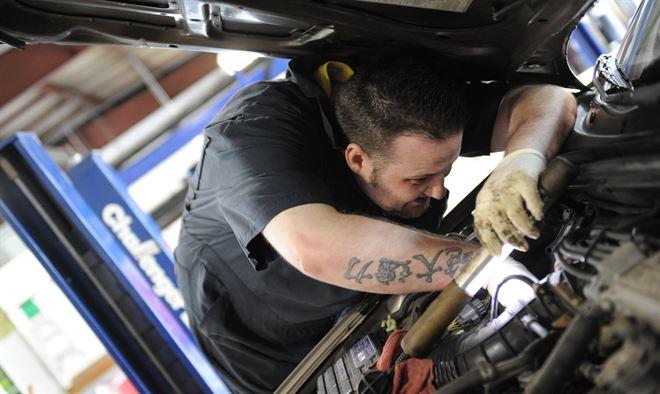
If you’re an automotive mechanic, chances are you’re familiar with back pain. All the bending, twisting, and working in compromising positions is incredibly strenuous on the lower back. Luckily, there are myriad ways to protect your back and keep you as pain-free as possible while working.
Strengthen your core
One of the most overlooked aspects of back health is having a strong core. This means abdominal exercises. Aim to start slowly—many ab exercises require a solid foundation before they should be attempted. Standard crunches and in-and-outs are excellent places to begin.
- Crunches – Begin with your back flat on the floor. You legs should be bent and your feet should together or roughly hip-width apart. Cross your arms in front of your chest with your fingertips resting on either side of your collarbone (you can also place your hands behind your head with your fingertips by your ears, and this can make crunches more challenging). Focus on contracting your abdominal muscles as you sit up until your elbows touch your knees or until your shoulder blades are clearly off the floor, and then gently lower back down. Pattern your breathing so you are exhaling as you sit up and inhaling while you lie back down.
- In-and-Outs – Start in a seated position as if you were at the top of a crunch. You may place your hands behind you for stability. In a controlled motion, extend your legs out straight in front of you while you lean back slightly, and then bring your knees back to your chest. Pattern your breathing so you are exhaling as your extend your legs and inhaling as you bring them back towards you.
Stretch
Lower back pain is often caused by overuse and tightness. While there are many stretches designed to help the different levels of the spine, but cat/camel and the gluteal stretch are excellent for the lumbar spine, specifically.
- Cat/Camel – Begin on your hands and knees. Your knees should be in line with your hips and your hands should be in line with your shoulders. Begin by inhaling while you look forward, keeping your neck long, and arching your back to lower your belly towards the floor. As you exhale, arch your back upwards and turn your head inwards to look at your belly button. Repeat this slow, rhythmic breathing 3-5 times, then return to neutral spine for a few breaths. Then switch your breathing so that you are inhaling while you arch your spine upwards and look towards your stomach, and exhaling while you look forwards and ease your belly towards the floor.
- Gluteal Stretch – Begin by lying on your back as though you were about to begin crunches. Cross your right leg over your left so that your ankle or calf muscle is resting on your left thigh. Reach your right hand through the gap in your legs and your left hand around the outside, grabbing around the front of your knee. Grabbing behind the knee can cause hyperextension, so be sure to reach all the way around if possible. Pull your knee towards your chest until you feel the stretch. Breathe here 5-10 times, easing deeper into the stretch on each exhale, and then switch sides and repeat.
Don’t Fear the Foam Roller
The foam roller is a fantastic tool to help lower back pain, when used correctly. A reliable way to relieve pain and tension in the lower back is to begin with the foam roller below your lower back and pull your right knee towards your chest as if you were doing the gluteal stretch. Keep your other leg out straight in front of you for balance and support, and roll from just above your glutes to the bottom right of your rib cage. Do this for 10-12 careful repetitions, and then switch sides.
As a reminder, none of these stretches or exercises should feel painful. If you experience any pain or discomfort outside the norm for exercise, cease the motion and give us a call today!
Request Appointment
Get Directions!
Hours
| Monday | 9:00 am – 6:00 pm |
|---|---|
| Tuesday | 9:00 am – 6:00 pm |
| Wednesday | 9:00 am – 6:00 pm |
| Thursday | 9:00 am – 6:00 pm |
| Friday | 9:00 am – 6:00 pm |
| Saturday | Closed |
| Sunday | Closed |
Areas We Serve
Portland Chiropractic Office: Located in the East Portland/Gresham area means our offices are easily accessible from I-205 and I-84 for your convenience. Our Portland chiropractic offices are conveniently located in Portland near Gresham. Our service area includes Portland, Gresham, Troutdale, Parkrose, Mount Tabor, Mill Park, Wood Village, Fairview, Clackamas, Rockwood and the rest of the Portland Metro Area including Vancouver, Washington. If you're in the area, just search "Chiropractors Near Me" and you'll find us.